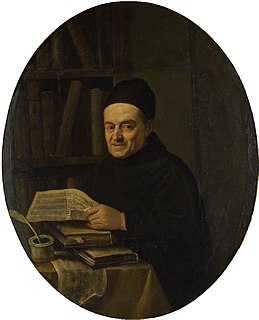Life
Paris
In November 1653, Caproli and his wife went to Paris, where he was commissioned by Cardinal Mazarin to compose the opera Le nozze di Peleo e di Theti (music lost) with an Italian libretto by Mazarin and Francesco Buti. The premiere, which included ballet intermèdes with a French text by Isaac de Benserade and music by uncredited French composers, was given on 14 April 1654 at the Théâtre du Petit-Bourbon with decors by Giacomo Torelli. The 15-year-old King Louis XIV appeared in no fewer than six roles. The production received nine performances, the final two open to the public, and it was considered a great success, although this was primarily due to the French ballets in the intervals. [2] [6] For his efforts, Caproli was made maître de la musique du cabinet du Roy, which suggests he may have directed the performances. [2]
Later career in Rome
Caproli returned to Rome in 1655. He again directed the music for the festival of San Girolamo and, as one of the best violinists in the city, made numerous appearances, including at San Luigi dei Francesi, Santa Maria Maggiore, and Santa Maria del Popolo, where he played for the Vespers of 8 September. In 1665 he took up the post of guardiano of the instrumentalists at the Congregazione dei Musici di Roma (later the Accademia di Santa Cecilia). [2] He composed numerous solo and ensemble cantatas, many with instruments, and several oratorios. [3]
Caproli died in Rome just before 20 December 1668, the day on which his will was opened. [1]

Giuseppe Ottavio Pitoni was an Italian organist and composer. He became one of the leading musicians in Rome during the late Baroque era, the first half of the 18th century.

Giovanni Battista or Giambattista Martini, O.F.M. Conv., also known as Padre Martini, was an Italian Conventual Franciscan friar, who was a leading musician, composer, and music historian of the period.
The year 1725 in music involved some significant events.
Giuseppe Maria Gioacchino Cambini was an Italian composer and violinist.
The Naples Conservatory of Music is a music school located in Naples, Italy. It is situated in the complex of San Pietro a Majella.

Teodulo Mabellini was an Italian composer.
Cataldo Vito Amodei was an Italian composer of the mid-Baroque period who spent his career in Naples. His cantatas were important predecessors to the active cantata production of 18th-century Naples, and he stands with the elder Francesco Provenzale and younger Alessandro Scarlatti as among the principal cantata composers. Other surviving works include a book of motets dedicated to Leopold I, Holy Roman Emperor; a serenata; two pastorales; two psalms; and four oratorios, which were important contributions to their genre.

Clorinda Corradi was an Italian opera singer and one of the most famous contraltos in history.

Demetrio e Polibio is a two-act operatic dramma serio by Gioachino Rossini to a libretto by Vincenzina Viganò-Mombelli. The opera was orchestrated for flute, oboes, clarinets, basson, horns, trumpets, and strings.

The Museo internazionale e biblioteca della musica is a music museum and music library in the Palazzo Aldini Sanguinetti, in the historic center of Bologna, Italy.
Mario Capuana was an Italian composer of motets and a requiem.

Luca Antonio Predieri was an Italian composer and violinist. A member of a prominent family of musicians, Predieri was born in Bologna and was active there from 1704. In 1737 he moved to Vienna, eventually becoming Kapellmeister to the imperial Habsburg court in 1741, a post he held for ten years. In 1765 he returned to his native city where he died two years later at the age of 78. A prolific opera composer, he was also known for his sacred music and oratorios. Although his operas were largely forgotten by the end of his own lifetime and most of their scores lost, individual arias as well some of his sacred music are still performed and recorded.
Angelo Maria Mazzia was an Italian painter. He was son of the painter Francesco Mazzia.
Museo Civico may refer to:

La conversione e morte di San Guglielmo is a sacred musical drama in three parts by the Italian composer Giovanni Battista Pergolesi. The libretto, by Ignazio Mancini, is based on the life of Saint William of Aquitaine as recounted by Laurentius Surius. It was Pergolesi's first operatic work, possibly written as a study exercise for his conservatory. The work was premiered at the Monastery of Sant'Agnello Maggiore, Naples in the summer of 1731.

Ferdinando Giorgetti was a composer, violinist, educator and Italian publicist.
Pietro degli Antonii was an Italian composer.
Giuseppe Paoloucci was an Italian composer, conductor and organist of Baroque music.
This page is based on this
Wikipedia article Text is available under the
CC BY-SA 4.0 license; additional terms may apply.
Images, videos and audio are available under their respective licenses.









